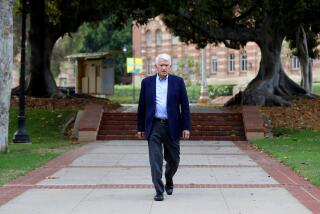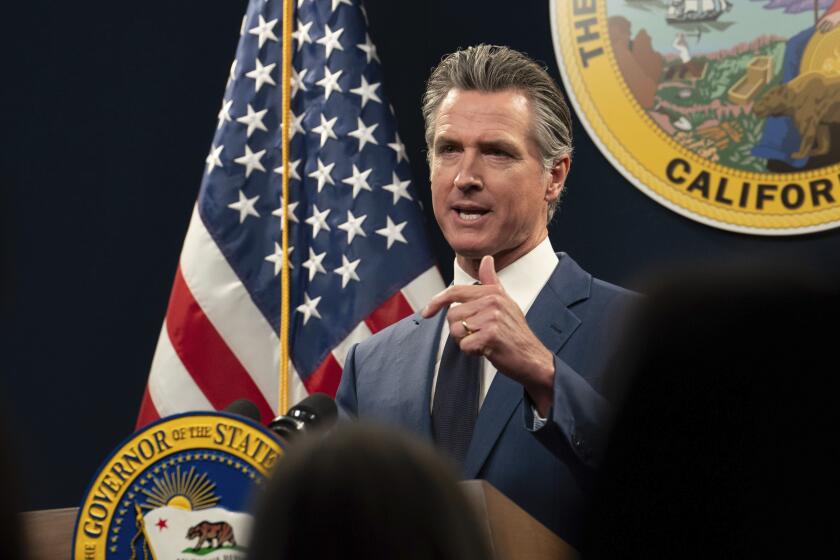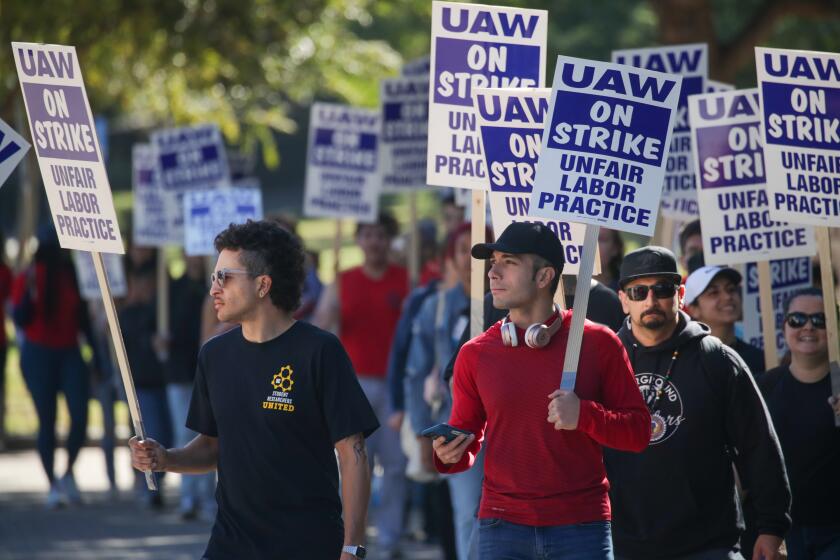Cutbacks May Squeeze L.A. Unified Subdistricts
Deborah L. Leidner oversees 70 schools and 73,000 students in a system almost the size of Fresno’s. But despite the breadth of her responsibilities in a swath of the San Fernando Valley, Leidner does not head an independent school district.
She is superintendent of Local District A, one of 11 subdistricts created nearly four years ago by the Los Angeles Unified School District. The goal was to bring services closer to the schools and help them raise student achievement.
“We’re here to provide all the support services the schools need to do the job,” Leidner said. She likes to think of the District A offices in a rambling Northridge business park as a “one-stop shopping center” for schools, providing everything from cafeteria services to reading coaches.
But the subdistricts, under attack by the teachers union and others almost from the start, now also find themselves the target of budget cuts.
Although it seems unlikely that their harshest critics will get their wish of dismantling the subdistricts, there is talk of consolidation -- perhaps down to eight -- or some other reconfiguration of the system.
Struggling to eliminate an estimated deficit of $489 million in the fiscal year that begins July 1, the school board recently lopped 20% from each local district’s general operating budget (and from central district offices too). The school board, which needs to chop about $61 million more, has directed the superintendent to look at further cuts in the local districts and central office.
“I think we’re wondering whether we have to have 11 food service directors, for instance, or 11 business services directors,” said board member David Tokofsky, who has questioned the salaries and staffing levels in the subdistricts.
The teachers union takes a much harsher view. It has repeatedly urged the board to abolish what it derisively refers to as the “mini-districts.”
The semiautonomous local districts were developed in early 2000 by Ramon Cortines, the troubleshooting interim superintendent. He wanted to reduce the district’s massive central bureaucracy and shift many headquarters employees -- and much of the power over budgets, hiring and instruction -- to smaller administrative units.
The stated primary goal was to improve academic achievement, especially in reading. But many saw a political motivation as well: The nation’s second-largest school district was under pressure from various groups working for its breakup. Carving L.A. Unified into 11 subdistricts -- each about the size of the San Francisco or San Bernardino city school system -- also was billed as a way to put decision makers closer to the campuses and families.
When former Colorado Gov. Roy Romer took over as superintendent July 1, 2000 -- the same day the subdistricts officially opened -- he embraced the new system. He and others credit the arrangement with helping to raise test scores and make other recent gains in the long-beleaguered district.
For example, Leidner and her Local District A team of about 90 math and literacy coaches, health services coordinators, special education experts, business services staffers and others help schools meet their achievement goals and solve problems. She said she walks a fine line between “being a cheerleader and knowing when to kick butt.” She and the 10 other local superintendents, each earning $155,000 a year, oversee subdistricts ranging from 59,000 to almost 80,000 students. To enhance communication, each district has a community advisory board, and the superintendents meet with Romer every Friday.
Altogether, the districts accounted for nearly $118 million of the district’s $5.7-billion 2003-04 operating budget and employed 987 of the district’s roughly 75,000 employees, budget officials said. They did not count $65 million in so-called pass-through funds administered by the local districts but spent primarily at schools.
The subdistricts’ individual budgets range from $9.2 million for Local District D on Los Angeles’ Westside, which has the smallest enrollment (59,000), to around $12.2 million each for Local District B in the East Valley, with almost 80,000 students, and Local District F, on the Eastside, where enrollment is less than 65,000 but where campuses are more crowded and test scores are low in more schools.
Critics of the system say they believe that the subdistricts’ budgets and numbers of employees are higher than the district acknowledges. Officials of United Teachers-Los Angeles complain that they cannot get the budget information they need, a charge that district officials strongly dispute.
The union issued its most recent call for the local districts’ dissolution at a school board budget session earlier this month.
“It is time to get rid of the mini-districts,” union President John Perez told school board members, a majority of whom his union helped to get elected. He said classroom teachers, not the local districts, should get the credit for rising test scores.
“Mini-districts do not contribute to the work of classroom teachers,” Perez said. “Mini-districts have not helped my members plan authentic professional development activities or worked with teachers to create a mentoring or coaching system that helps new teachers stay in the profession or improve their craft.”
Another critic of the local districts is Associated Administrators of Los Angeles, which represents about 2,700 principals, their assistants and other middle-management employees.
“You do need some kind of structure” between the general superintendent and the principals, said Dan Isaacs, who headed the district’s former high school division but now is administrator for the union. “But it doesn’t need to be as loaded up as this.”
Isaacs cited Cortines’ original plan, in which the then-superintendent promised to cut 843 jobs in downtown headquarters (about 500 of which he planned to relocate to local district offices) and save $47 million.
“That just never happened,” Isaacs said.
District officials counter that they have fewer employees now than even two years ago and have cut about $1 billion from their operating budget over the last three years.
Romer said the 11-district system has been “highly effective” at implementing board of education policies while maintaining the flexibility to drive reforms and improve test scores in ways that best serve their communities.
Some of the criticism, Romer suggested, came from teachers and principals “who are feeling the heat to improve, and they don’t like the pressure.”
The subdistricts have been cut in previous years. Given the size of the district’s budget problems and its goal of keeping the effects as far away from the classroom as possible, further cuts may be inevitable, Romer said.
“I have slimmed them down very hard, and I will slim them down some more,” he said. “The decision I’ve got to make is: How thin they can get and still be effective?”
Romer said he was trying to find services, such as business, food and nursing, that could be shared among districts or run with fewer people from the downtown offices. He also might consolidate the districts, if it could be done without jeopardizing gains in elementary pupils’ achievement and efforts to improve results among middle and high school students.
A Cal State Northridge expert on school district administration said the system of local districts made a lot of sense, although he would create more, smaller subdistricts and would add, not subtract, employees and support services.
“The research tells you that smaller is better,” said Richard Castallo, chairman of the university’s department of educational leadership and policy studies.
“When you depersonalize the system, when the community and parents have questions and no one to answer them, the accountability gets lost,” he said.
Leidner, the District A superintendent, is a 33-year veteran of the district who remembers previous mid-level arrangements, including clusters -- which centered on high schools and their feeder campuses -- and areas. She headed one of the clusters before the local districts were created. The local districts made more sense, she said, because they are were able to solve problems much faster.
“Under clusters, if we had a problem with a special education student,” Leidner said by way of example, “we would have to call downtown for help and it would usually take several days to resolve things. Now, I just walk down the hall to my special-ed office, and we can have a solution by the end of the day.”
However, Steve Siry, principal of Nora Sterry Elementary on the Westside, said he found the cluster arrangement more effective, in part because the 27 clusters were smaller than the 11 subdistricts.
Doug Waybright, principal of Carson High School, said he preferred an even earlier system in which high schools were a separate division.
“Principals get the most support and guidance from their own colleagues, people who deal with the same issues and problems they do,” he said.
Leidner, one of four original local superintendents still at their posts, said she would hate to see the district’s financial problems erode a system she believed was working.
“There is something to be said for stability,” Leidner said. “But, whatever the configuration of the district offices might be, we’ll make it work.”
More to Read
Start your day right
Sign up for Essential California for news, features and recommendations from the L.A. Times and beyond in your inbox six days a week.
You may occasionally receive promotional content from the Los Angeles Times.







